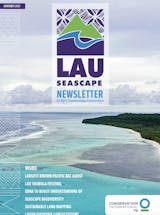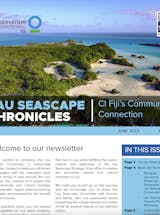In the South Pacific Ocean lies a scattered and thriving archipelago known as the Lau Islands. This remote and hidden beauty comprises nearly sixty islands, only half of which are inhabited — making it one of the most isolated places on Earth.
This Fijian island chain is pocked with deep harbors and towering limestone cliffs, where coastal waters teem with whales, manta rays and sea turtles. A complex coral reef system provides habitats for marine life and livelihoods for the Indigenous people of Lau, whose unique culture dates back over a thousand years.
But climate change is threatening Lau’s vital marine and coastal areas, as well as its peoples’ sources of food and income. And though tourism remains low, that is quickly changing. As more visitors arrive, infrastructure is needed to keep pace and protect fragile ecosystems from boat traffic and human interference.
These changes prompted a new plan for a sustainable future. With support from the Fijian Government, Lau's traditional leaders launched a plan in 2019 alongside Conservation International and partners to conserve their ocean as a seascape. Already underway, this comprehensive ridge-to reef-to ocean approach will sustain vibrant biodiversity, while ensuring the livelihoods of the people of Lau.
Why is it important?

Biodiversity
The Lau archipelago is home to remarkable biodiversity, including species that don’t exist anywhere else in the world. Over the past decade, Conservation International and local partners have discovered species that are new for Fiji — and some that are new to science. The island chain is also a waypoint for migrating marine species like whales, and its reefs are a breeding ground for both the endangered green and hawksbill turtles.

Ocean and people
Pacific civilizations were built on a symbiotic relationship with the ocean. It remains a pillar of Fiji’s prosperity, providing food and driving its economy. Located between Melanesian Fiji and Polynesian Tonga, Lau has a unique blend of cultures and encompasses the largest ocean area of Fiji’s provinces.
This 335,000 square kilometer (129,000 square mile) area represents over a quarter of the Fiji’s marine realm. A significant percentage of Fiji’s ocean goals have been pledged by Lau by communities that make up just 1 percent of country’s population. This includes around 8 percent of Fiji’s goal to protect 30 percent of its ocean area, and one-fifth of the national goal to restore 1 million corals.
What are the issues?
Climate change is increasingly impacting the coastal communities and marine ecosystems of the Pacific. Sea level rise, ocean warming and acidification threaten coral reefs and traditional ways of life, while tropical cyclones are becoming more frequent. At the same time, industrial fishing — combined with overharvesting of coastal fisheries to meet demand for giant clams, sea cucumbers and other luxury seafood — is leading to degraded coral reefs ecosystems across Lau. On land, deforestation and intensified agriculture are harming the island ecosystem’s delicate balance.
Protecting the Lau Seascape
With support from Conservation International, the Indigenous people of Lau are building an approach to ocean conservation that balances protection and production for the marine ecosystems they depend on.
The seascape is the result of significant stakeholder engagement, scientific research and visionary thinking. It unites a broad range of stakeholders from Lau’s communities, representing 13 tikina (districts), the government of Fiji, the private sector and non-governmental organizations — all focused on protecting Lau’s biodiversity and ecosystems, promoting climate resilience and adaptation, and promoting sustainable development solutions for the people of Lau.
Our plan

Legal establishment and sustainable financing
For the Lau Seascape to effectively deliver an economy that sustains both its people and its nature it must be legally protected. This will enshrine natural resource management and govern how nature is treated under law. Equally vital to the success of the seascape is financing to support its protection and management. Conservation International is working to secure formal agreements from each of Lau’s 30 chiefs to create a financing structure for the initiative.

Climate adaptation and resilience
Conservation International is investing in nature-based solutions to confront climate change. We support ecosystem restoration, protection and management, as well as climate resilient livelihoods for island communities. This includes increasing community-based reef restoration and fisheries management, and establishing marine protected areas that track and monitor the impacts of climate change on coral reefs.

Scientific research
Lau’s stunning — and largely unexplored ecosystems — are the focus of scientific research that is already rendering new species to science. Conservation International is assessing the biodiversity of the reefs and other key ecosystems to support a better understanding and management of Lau’s environment.

Indigenous-led marine protection
Three nearshore community-based marine managed areas — Navatu, Duff and Cakau Nawa — as well as 52 coastal community-based marine managed areas have been established in partnership with local communities, utilizing Lau’s traditional no-take zone approaches. These areas support healthy fish stocks and provide a refuge for migrating species, such as marine turtles, which visit these waters to breed.

Restoring corals and forests
Conservation International is working with Lau communities to reinvigorate degraded coral reefs through an initiative to plant 200,000 corals across the seascape. This represents one-fifth of Fiji’s national goal to plant 1 million corals. Our team is also assessing restoration sites in Lau and training Lau villagers to lead native forest restoration efforts.
Videos
Journey to Fiji's Lau islands and learn how Indigenous leaders are conserving this pristine tropical archipelago and supporting local economies to deliver a sustainable future for people and nature. How? Through the Lau Seascape Strategy, a visionary approach which promotes environmental and social outcomes. The strategy aims to maintain Lauan traditions and promote sustainable development while also delivering a comprehensive land and marine management approach for the province, which makes up over a quarter of Fiji's ocean area. Supported by Conservation International, this 'protection and production' approach builds on scientific research of archipelago, which holds globally significant coral reefs and marine habitats frequented by turtles, manta rays, and whales. Despite looming climate threats, Lau stands as a beacon of hope, demonstrating a commitment to balancing the needs of people and nature for long-term prosperity. Learn more at www.conservation.org/lau
An expedition to a little-explored region in the Pacific offers insights, and hope for protecting coral reefs in a changing climate. Thank you to the Fijian government and our many partners including the Living Ocean Foundation, the Pacific Blue Foundation, the Fiji Department of Fisheries, the Lau Provincial Council, the Fiji Locally Managed Marine Area Network, and the University of South Pacific for their #OceanAction19904 commitment, including the protection of the Lau Seascape. More on this expedition: http://stories.conservation.org/treasures-of-the-lau-islands
Nearly all sea turtles are classified as Endangered. Five of the seven sea turtle species can be seen in in Fiji’s Lau Seascape. There, Conservation International is working with scientists and local communities to study and protect these animals. This research identified Duff Reef, a remote sand cay in the Lau Seascape, as an important sea turtle nesting ground. This led the Indigenous land owners to declare Duff Reef a turtle sanctuary so that the turtles will be protected for generations to come. Learn more about the Lau Seascape at www.conservation.org/lau
More from the Lau Islands
In 2017, Conservation International conducted a Rapid Assessment Program on eight islands in Southern Lau to gather baseline information on biodiversity and ecosystem health. The expedition highlighted areas of significant biodiversity that require protection, as well as ecosystems that have been overexploited and require management for restoration.
- Treasures of the Lau Islands
- Unexpected finds: Survey sheds new light on reefs
- New species: Survey finds species new to science
- Chief’s view: Local people hold key to protecting reefs
- Lau reefs offer clues to protecting coral
- In Lau, a key species in decline
- 300 hours underwater
- Epilogue: Discoveries in the Lau Islands will pave the way for Fiji's conservation future









